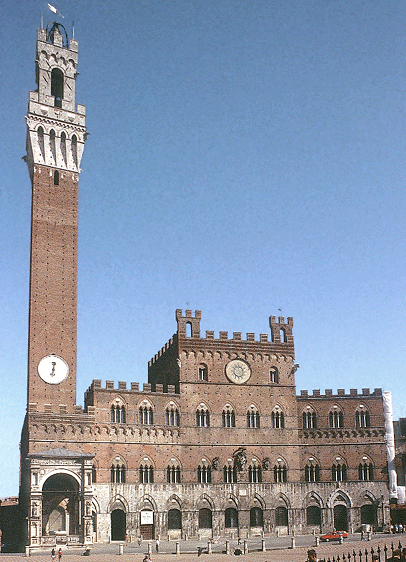Palazzo Pubblico
Siena, begun 1297
PIAZZA DEL CAMPO
Design
The Palazzo Pubblico in Siena stands on the Piazza del Campo, a large piazza in the heart of the city. The piazza is also known as the "Campo."
The building's center is located at the point of convergence of the radiating lines. These lines divide the pavement into nine sections representing the nine governing officials known as the "Nine Governors and Defenders of the People of the City."
Because of its somewhat semicircular shape and the presence of radiating lines, the piazza is often compared to a fan or shell.
Although not perfectly symmetrical, the piazza's shape was more balanced than that of most piazzas of its time.
Uniformity of Surrounding Buildings
The Campo represents an early instance of town planning. The visual unity of the buildings that surrounded the piazza was assured by an ordinance restricting the use of balconies and enforcing uniformity in window placement, number of stories, and general character.
Function as a Racetrack
In addition to serving as a place for religious and civic ceremonies, the Campo was used for spectacular events like jousting and horse racing.
A tradition that began in the fourteenth century and continues today is an annual horse race called the Palio. The purpose of the race was to claim Siena's palio, or ceremonial banner.
The race originated as a celebration of holy days. Then and now, before the race, the jockeys attend Mass in the Cappella di Piazza.
In the distant past, as the horses raced around the perimeter of the piazza, the jockeys used long whips on each other in an effort to ensnare and unseat their opponents. Inside the Palazzo Pubblico there is a medieval depiction of the race showing the jockeys wielding whips.
Today the jockeys carry shorter whips that allow them to preserve the tradition of harassing each other with less brutal results.
Medieval costumes for the jockeys and trappings for the horses add to the pageant-like atmosphere of this event, which attracts many tourists.
CONSTRUCTION OF THE PALAZZO
Stages of Construction
Despite the unified appearance of the façade, the building was constructed in stages.
●Center section. A four-bay center section was begun in 1297.
●Wings. The wings were added next. Although an alleyway separates the center section from the left wing, the wing that housed the Podestà, this break is concealed by the use of a continuous symmetrical façade.
●Tower. The campanile, the Torre della Mangia, was added between 1325 and 1344. The tower's height of 87 meters was a source of great pride to the citizens of Siena.
●Cappella di Piazza. The stone porch at the left, the Cappella di Piazza, was begun in 1352 and completed in 1376 as a chapel memorializing the victims of the great plague of 1348 known as the Black Death. The chapel was altered in the 1460s.
●Upper stories on wings. A third story was added to each of the wings in the 1680.
Materials
The stone trim forms a distinct contrast in color, texture, and decorativeness to the brick that covers most of the palace. Stone trim surrounds the windows and faces the ground story, the porch-like chapel, and the upper part of the tower.
FRESCOES DECORATING THE INTERIOR
Themes
The interior walls are decorated with fresco paintings by the leading painters of Siena. Both civic and religious themes are depicted.
Famous Paintings
♦ Allegory of Good and Bad Government, Sala dei Nove (the Nine). Ambrogio Lorenzetti's Allegory of Good and Bad Government includes a panoramic view of Siena and the surrounding countryside and demonstrates the effects of good and bad government.
♦ Maestà, Sala del Mappamondo. In 1315 Simone Martini was commissioned to paint a large Maestà, an image of the Virgin Mary holding the baby Jesus and surrounded by a number of saints for the Sala del Consiglio.
♦ Giudoriccio da Fogliano, Sala del Mappamondo. The attribution of the painting known as Giudoriccio da Fogliano to Simone Martini is no longer accepted. In this work, the condottiere Giudoriccio da Fogliano, who fought for Siena, is on horseback in the center of a lonely landscape that includes his military encampment and two cities he conquered for Siena.

Palazzo Pubblico, Siena



 Add Placemark
Add Placemark Go Back
Go Back 




